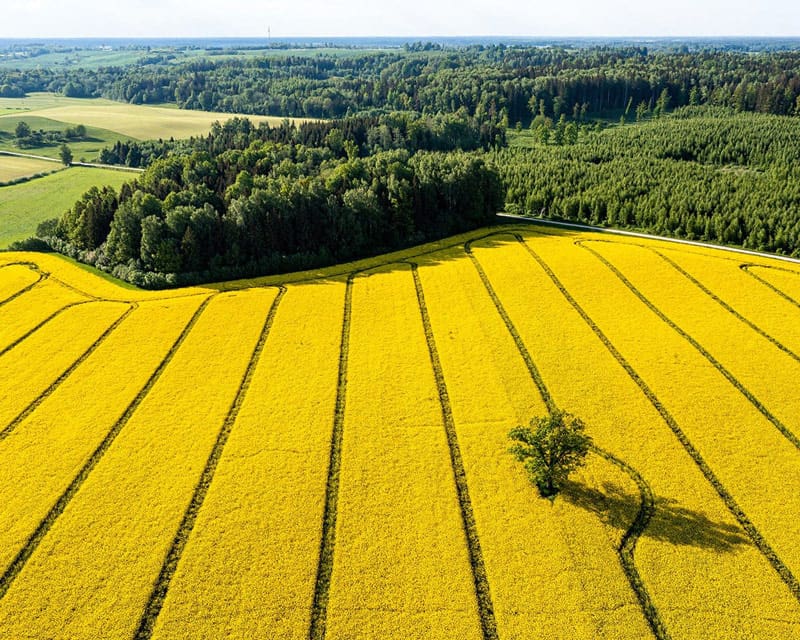Russian Ministry to meet exporters to discuss potential Russian wheat export restrictions
Sources tell Expana that the Russian Ministry of Agriculture is set to convene with grain exporters on Friday, Oct.11, to discuss potential restrictions on grain exports. Industry players believe these restrictions may be driven by a combination of a smaller-than-expected grain crop and an unsustainably high export pace.
A contact from Expana remarked, “I think they want to make the market fly. There are some rumors they want to set a price floor at $250/mt FOB, like what was done a year ago, or take unofficial steps like delaying the release of mandatory phytosanitary documentation.” This comes at a time when the Ministry is also expected to announce the country’s official 2024/25 wheat crop size, which, according to several sources, will likely be lower than previous estimates due to unfavorable weather conditions. “Some assume that these two issues are connected,” the source added.
Market players have noted a striking absence of offers for Russian 12.5% milling wheat at FOB for October delivery. The lowest offer in the market stands at $235/mt FOB, with buyers showing interest at this level. For November delivery, offers have risen to $237-239/mt, reflecting growing uncertainty around supply.
These developments follow earlier reports that export quotas are expected to be introduced in October or November 2024. The anticipated quotas are aimed at covering shipments between the second half of February 2025 and June 2025.
China’s 2024/25 corn consumption to hit record amid high feed demand
Due to the recovery in feed consumption and a growth in overall demand, China’s total corn consumption for the 2024/25 season is expected to reach nearly 300 million tonnes, an increase of more than 4.5 million tonnes from the previous year, setting a new historical record, according to new figures released by China’s Ministry of Agriculture and Rural Affairs (MARA). “Maintaining a regular purchasing rhythm and avoiding blind pessimism may prove to be the most prudent strategy in this year’s corn market,” reports MARA.
Of this, about 70% of total corn consumption in China is used for feed purposes. China’s corn consumption for feed use in the 2024/25 season is expected to reach 193.5 million tonnes, an increase of about 2.5 million tonnes from the previous year “Demand for corn in the feed and livestock industries continues to rise. Recent growth in feed production has been significant, driven by improved profits in pig farming after a sluggish few years,” said MARA.
According to data from the China Feed Industry Association, in August 2024, national industrial feed production reached 27.83 million tonnes, representing a 5.0% m-o-m increase, with corn accounting for 31.2% of compound feed, up 5.6 percentage points y-o-y. As per usual trends, Q4 is the peak season for livestock product consumption, which will inevitably further boost demand for corn in feed.
Previously, in 2023, due to heavy rain in key production areas such as Henan, a higher proportion of sprouted wheat entered the feed sector, resulting in over 30 million tonnes of wheat being used for feeding throughout the year. However, moving forward, the substitution of wheat for corn in feed has significantly decreased.
Agricultural commodity markets wait for outcome of vote to delay EUDR by 12 months
In reaction to pressures from industries and governments, the European Commission (EC) last week proposed a 12-month delay to the EU Deforestation Regulation (EUDR), which is scheduled to come into effect on December 30, 2024 – impacting the imports of agricultural commodities such as cocoa, coffee, cattle, soy, palm oil, timber, rubber, chocolate, leather, and other products. The proposal has sparked outrage among environmentalist organizations, with Sébastien Risso, Greenpeace’s Forest Policy Director, saying that “Ursula von der Leyen might as well have wielded the chainsaw herself!”
The delay proposal, however, still needs to be approved by the European Parliament and member states, the EC said, adding that a vote would likely happen in November or December 2024 at the latest. A 12-month delay – meaning EUDR would come into force on December 30, 2025, for large companies and June 30, 2026, for micro and small enterprises – would provide more time to European primary producers and various industries to address the practical challenges associated with the EUDR’s implementation to prevent uncertainties and avoid supply chain disruptions.
The EC proposal for a 12-month delay was welcomed by EU animal feed industry body FEFAC last week. “FEFAC invites the European Parliament and the Council to adopt all related EUDR implementation measures to allow this transition to take place without jeopardizing vital feed supply chains for soy (of both EU and non-EU origins) and palm oil (co-)products. FEFAC members remain committed to promoting the use of responsibly produced, deforestation-free soy in animal feed by the FEFAC Soy Sourcing Guidelines,” said FEFAC President, Pedro Cordero.
However, FEDIOL, the EU vegetable oil and protein meal industry association, representing the interests of the European oilseed crushers, vegetable oil refiners and bottlers, warned that “companies [in the sector] have made high-risk investments to be able to be ready by the date of application. As a result of the likely postponement of the date of application, those companies will inevitably suffer losses in their investments.” FEDIOL added: While postponement seems to become inevitable, postponement alone will not make the future of EUDR implementation more secure. FEDIOL therefore continues to stress the necessity for the European Commission, Member States, and competent authorities to provide needed clarifications and consider practical solutions able to make the regulation workable and protective of the competitiveness of the EU food system.”
Meanwhile, paper producers in the EU are certainly keen to increase the share of recycled paper in production and reduce the consumption of pulp, which is produced from wood. However, paper producers and consumers are wary of changes in the rules of the game on the wood market, as this could bring a shortage of pulp to the market and be reflected in higher prices. According to Artem Segen, Industrials and Packaging market reporter at Expana, the increase in paper production in the EU in H1 2024 was reflected in a shortage of pulp, when pulp prices rose rapidly. “On the other hand, demand in the paper market has been growing slowly, and excess paper production capacity has created a high availability of paper in the market. As a result, producers were unable to increase the prices of their products in line with the increase in pulp prices. Therefore, if the EU Deforestation Regulation (EUDR) is implemented as scheduled and not postponed, papermakers are likely to face a new round of raw material price increases, which could again be reflected in falling paper production margins,” he commented.
Agri-Food Americas: Adapting to market challenges in feed, grains & oilseeds
Expana’s Ollie Theocharous, Content Director of Events, led the Feed, Grains & Oilseeds Leaders panel that addressed the key challenges faced by buyers and sellers in the agrifood sector, particularly considering the ongoing impacts of the Russia-Ukraine war.
Thomas D’Alfonso, Director of Animal & Aquaculture at the U.S. Soybean Export Council (USSEC), participated in the discussion that explored strategies for managing rising costs and defining true sustainability within the industry. The conversation also focused on building resilient supply chains and preparing for future challenges. USSEC is dedicated to differentiating and enhancing preference for U.S. soy while securing market access for its use in human consumption, aquaculture, and livestock feed across more than 80 countries worldwide.
Together with D’Alfonso, the discussion featured Mark Soderberg, Senior Agricultural Research Analyst at ADM; Dan Kowalski, Senior Director of Global Economic Research and Foresight at Land O’Lakes; and Drew Weir, Vice President of Commercial Operations at Huvepharma.
When it comes to the most pressing challenges that buyers and sellers are currently facing in the feed, grains, and oilseeds markets, D’Alfonso broke it down to the Four C’s: Climate. Conflict. Currency, and Catastrophe. “The other ‘C’ used to be COVID, but hopefully that’s behind us. With catastrophe, remember it was only 6 months ago when a boat crashed into the Chesapeake Bridge. That was a good case study of how to make supply chains resilient when people came together.”
Soderberg added that volatility is a major stressor. “When surprises hit the market, they hit the market with a great deal of force, and price changes happen very quicky. Volatility is going to be a constant going forward.”
Weir weighed in from a feed additives perspective. “Consolidation is the number one issue facing us as a manufacturing partner that operates across multiple regulated bodies. Maintaining these products includes dealing with live animals and disease challenges.”
At Land O’ Lakes: “We think about grain and oilseeds going into the feed supply. Sourcing micro-ingredients like vitamins and minerals from China is a challenge. Also, we’ve noticed that we have shorter periods of stable weather than we did 10-15 years ago. This presents challenges for purchasing because routine cycles become nonroutine.”
Labor was also listed as an issue. Following the recent port strike at the East and Gulf Coasts, there are concerns that the hike in wages could be passed down to consumers.
How can businesses adapt to these various market challenges? “You have to get sharp on risk management and how you source your inputs. We are trying to use secondary and tertiary suppliers so that we don’t want to get caught in situations we were in during the pandemic,” said Kowalski.
Resilience is key, particularly during times of geopolitical uncertainty. “You should always be resilient in your supply chains and options of where you source. USSEC wants everyone to buy U.S. soy. We encourage you to look at your return on investment,” added D’Alfonso.
Ultimately, there’s a deep connection between the commodities that flow throughout the world. “Global trade is alleviating and preventing a lot of crises that could be happening,” D’Alfonso explained. “Global trade is not just moving things in boats, etc. but it’s the people aspect and having relationships with people across the word.”
Agri-Food Americas: Extreme weather wreaks havoc on global agriculture
Extreme weather events are increasingly disrupting global food supplies, with 2023 seeing $21 billion in crop losses, according to Expana Weather Analytics Lead, Lucy Simmonds.
Speaking at the Agri-Food Americas event in Chicago on October 9, Simmonds noted that 21% of these losses were from corn, while $16 billion stemmed from drought, wildfires, and extreme heat. She emphasized the importance of tracking weather impacts on agricultural commodities as a key part of supply chain management. “In today’s uncertain environment, it’s crucial to monitor climate dynamics closely,” she said.
The uncertainty continues, with 2024 likely to set new global temperature records due to developing La Niña conditions. “During the last La Niña from 2020 to 2023, global temperatures dipped slightly but remained stubbornly high, showing the persistence of the warming trend,” Simmonds explained.
This ongoing warming is having global effects on agriculture. “We’ve seen weather-related crop issues in South America, Southern Africa, Eastern Europe, and Southeast Asia,” she added.
Satellite data, such as NDVI, offers an unbiased way to track these impacts. “Instead of relying on farmers’ assessments, which can vary, satellite tracking provides consistent, early insights,” Simmonds said.
As the climate shifts, traditional growing regions are also changing. “In the US, corn production is moving northward, as corn is more vulnerable to heat than soybeans, and most corn is rain-fed,” she said.
To address these challenges, Simmonds advocates for resilient farming techniques, including developing genetically engineered crops that are more heat and drought-tolerant. “Sustainable adaptation will be critical,” she concluded.
Want to dig into further insights? Discover more on our insights page.


